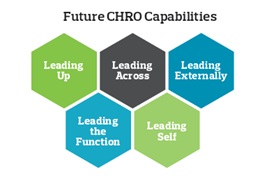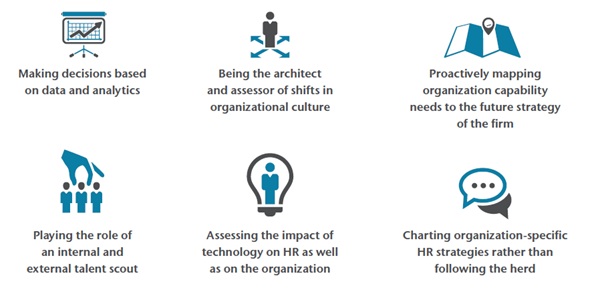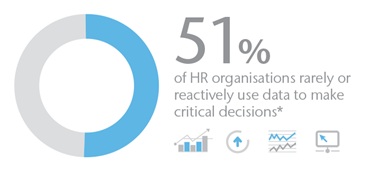HR Connect New Zealand – Volume 4, Issue 3, 2015
Developing the Next Generation of CHROs
Many organisations’ HR functions have responded to the challenge of living in a constantly evolving state of business, and there is recognition that the CHRO is a critical stakeholder in defining business strategy. However, there seems to be a widening gap between the expectations of what a CHRO brings to the table and the skills and capabilities of future CHROs - especially those from within HR.
Aon Hewitt’s ‘Learning to Fly’ study was a response to the following question: “Is HR developing its own leaders to tackle the challenges and evolving expectations of a dynamic environment?”
We interviewed 45 CHROs around the globe about their journey to the CHRO position. Our study focused on five key areas identified that future CHROs need to develop to be successful in their role.

Leading Up - Have a point of view
Two relationships critical for success are those with the board of directors and with the CEO.
The board and the CEO set the overall strategy for the organisation, and look to the CHRO to support that strategy from a human capital standpoint. The role of the CHRO is not merely to follow orders. If the board/CEO suggests a strategy that will have negative HR repercussions or goes against the employer brand, the CHRO must call that out and suggest alternatives.
Leading Across – Be the honest broker
The CHRO must manage incompatible agendas, interpersonal conflict, and the dynamics of being a peer to the C-suite while having a unique relationship with the board/CEO. S/he is called upon by these stakeholders to give objective advice about the performance of other CXOs, as well as aspects of organisational fit.
The CHRO should play the role of a coach to other CXOs, and also that of a sparring partner off whom they can bounce ideas. Rather than becoming a go-between for the CEO and other CXOs, the CHRO must coach both parties to have an open and honest dialogue.
Leading the Function – Adapt HR strategy to a context
The demands of the organisation on the HR function continuously evolve. There is an increasing need for change management expertise, an emphasis on using data to ask the right questions and using analytics to establish credibility. We noticed three distinct kinds of organisational contexts that CHROs must tackle. Depending upon the context, the CHRO could be a founder, a director, or a transformer.
Leading Externally – Voice of the organisation to the outside
In a connected world, all leaders of the organisation, including the CHRO, are expected to be the face of the firm to the external world. Networking with peers is also important for the HR function – a lot of learning transpires through bouncing ideas off others in a similar context or industry.
Leading Self – Blend the soft with the hard
As leaders grow in an organisation, their soft skills and competencies become more important than their technical skills, which they have demonstrated consistently.
Success in all the other areas spoken of so far—Leading Up, Leading Across, Leading the Function, and Leading Externally—depends upon the CHRO’s soft skills.
What the Future Holds
Here are the key trends on a three- to five-year horizon that CHRO aspirants should start picking up today.

You can download a copy of ‘Developing the next generation of CHROs: The Learning to Fly study’ here. For more information contact Jocelyn Anso on 09 362 9296 or by email at [email protected].
Building HR’s way of life around data
There is an unprecedented level of excitement about big data and data analytics in the global market. Everyone’s talking about it, everyone has a view on it, and most organisations we know are working to take advantage of it.
Within organisations, the finance, sales, marketing, and supply chain areas have increasingly relied on data and analytics to enhance their effectiveness and drive robust decisions. Despite the vast advancement in tools, technologies, behavioural sciences, and statistics, HR is the last function to truly utilise data for robust decision making.
Our perspective is that driving value though human capital analytics will be a strategic imperative for HR over the next few years. We believe that HR needs to adopt analytics as a lifestyle to truly evolve to the next stage of driving value to the business through data.

Source: *HR Joins the Analytical Revolution, Harvard Business Review, February 2014
Organisations that are adopting analytics as a lifestyle should be focused on a four step journey when looking to manage and fully utilise data within their firm.
They must start with a focus on the business issues and make sure they ask the right questions. With the right data amassed organisations can then focus on building data-driven narratives built on patterns and insights from the data. This narrative, combined with the HR professional or team leveraging their business acumen and their broad understanding of talent issues should help organisations to identify the critical few talent indices on which the particular organisation should focus – in line with their set objectives and current business issues.
The final step, and a core principle in making analytics a lifestyle within HR, is to develop a regular and disciplined cadence of reviewing data, metrics and findings. We believe it should become second nature for HR to explore key metrics each month/quarter, select insights from the data, and be able to proactively consult with the business on ways to move the needle and monitor results when specific interventions have been put in place.
While there are huge expectations from big data and predictive analysis in terms of the impact they can have on organisational effectiveness, we are seeing and learning that organisations cannot just make big investments and hire data scientists in the hope of getting stared on their analytics journey. In order to truly gain a return on investment, we think organisations need a long-term roadmap and a phased plan for their data and analytics journey.
For more information on analytics as a lifestyle download the whitepaper ‘An Analytics Lifestyle’ here, or to find out how Aon Hewitt can help your organisation with data and analytics contact Emma Le Grice on 09 362 9291 or [email protected].
Do your New Year’s resolutions include a Strategic Investment Review?
Sound investment governance is the foundation for meeting investment objectives in a sustainable manner, and an annual high-level review of the investment framework is part of good governance. With the end of the year approaching, now is a good time for superannuation plan investors and trustees to resolve to review key elements of their fund governance.
Strategic Review
At least every year, investors should formally review compliance with their investment governance framework. Items for review include:
- Assessment of investment performance versus the return and risk objectives;
- An assessment of risk management through investment processes and controls (e.g., asset class diversification to mitigate investment risk, dual sign-offs on investment changes as a control for fraud or negligence) and any recommendations for improvement relating to investment risk;
- Any emerging risks or issues relating to the governance of the investments;
- The results of risk specific stress testing (if any); and
- Outcomes of the ongoing monitoring and review of its appointed managers.
In addition, investors should conduct regular in-depth strategic reviews (at least triennially) considering:
- The appropriateness of the investment purpose, beliefs and objectives to the plan investor’s strategy;
- The appropriateness of the investment strategy in the context of the investment beliefs and business operations;
- Accuracy of the documentation of the investment strategy and associated framework; and
- The adequacy and effectiveness of all risk management policies, procedures, treatment and controls in relation to investment risk.
Investment Governance
Of course constructing a robust investment governance framework is a prerequisite for any meaningful review. Observing investment returns in isolation is not useful; success can only be measured in the context of investment beliefs, risk tolerance, and objectives. Investment governance is the foundation for meeting investment objectives in a sustainable manner. The main areas to consider in developing an investment governance framework are:

Each of the areas listed above requires reflection and discussion amongst the trustees responsible for a fund. For example, developing an investment strategy involves several components. Below is an overview of considerations for an investment strategy.
Investment Strategy
The investment strategy is the specification of an approach to reach the intended investment objectives. The strategy is aligned with the purpose and beliefs of the Board.
For example, if the trust is a charitable foundation and its purpose is to provide consistent, sustainable financial support to charities, the investment strategy may prioritise capital protection and risk management over capital growth. In this case, the strategy may consist of using term deposits to match commitments within 12-24 months and to invest the remainder of the capital in an investment with a robust risk control process, including a high degree of diversification across geographies, industries and asset classes.
Non-Investment Considerations
In the example of the charitable foundation, if the foundation is run by an institution that has specific views on types of investments that are harmful to society and therefore should be avoided, this is important to setting the investment strategy, i.e., negotiating mandates with fund managers that avoid companies engaged in certain activities (e.g., manufacture of cluster bombs or the use of child labour).
Government regulations may also greatly shape investment strategies. In some countries, there are limits on the proportion of a pension fund that can be invested in equities or severe restrictions on how much pension funds can invest outside of the country.
Elements of an Investment Strategy
Considerations that are part of an investment strategy may include the answers to a number of key questions. Examples are listed below.
- Are investments managed in-house or outsourced (e.g., pick individual stocks or pick external portfolio managers who select stocks)?
- Does the trust have enough funds to give an external manager a mandate, or are investments to be made in pooled unit trust structures?
- Which types of assets will be considered – hedge funds, private equity, global real estate investment trusts, infrastructure, listed global shares, domestic listed equity, direct property, direct fixed income, fixed income funds? Do investment beliefs or practical considerations exclude certain types of investments?
- What is the desired spread or diversification across assets? How is the asset allocation managed when market values change? Are there any minimum or maximum allocations to any particular asset classes?
- What foreign exchange risk exposure is acceptable? How will currency risk be managed?
- What degree of liquidity is required – is it a problem if it takes a quarter or a year to divest?
- What are the requirements for valuations (frequency, source of prices)?
- What standards are required for counter-party ratings?
The annual investment review process is akin to a spring-cleaning of a house, a time to clear away cobwebs, to check for unexpected cracks in the structure and to make appropriate adjustments. Every few years, a deeper review of the structure itself is warranted. Just as family may consider an additional room to a home, a trustee may consider adding new asset classes or make a larger allocation to alternative investments. The beginning of a new year is an excellent time to plan the annual spring cleaning to get the investment house in order.
For more information on how Aon Hewitt can help with a review of your superannuation fund’s investment governance structure contact Guy Fisher on 04 819 4054 or [email protected].
Personal objectives, needs or financial situations were not taken into account when preparing this information. Accordingly, you should consider the appropriateness of any general advice provided in this post having regard to your own objectives, financial situation and needs before acting on it. The information contained above is intended for general information purposes only and should not be construed as legal or investment advice. Please consult with your independent professional for any such advice.